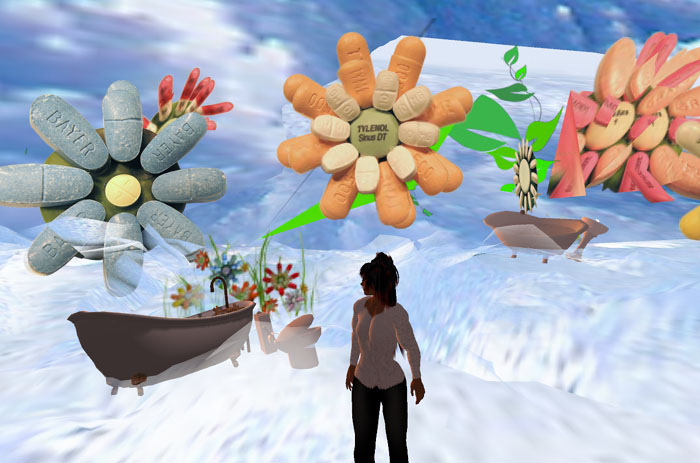|
Welcome to a critical review of virtual culture |
WHAT |
||||
| click on these links for: | RSS feed | Features | BLOG | Editorials | Contact |
Pillflower World
An interactive installation that addresses beauty, kitsch, approach and avoidance

Be sure to take the notecard when you arrive, and ride the sled for a brief tour on your way to the globe.
TELEPORT TO: Pillflower World, NMC Campus 7 (246, 5, 97)
FROM THE ARTIST:
PROJECT STATEMENT
Pillflower World, a mixed reality exhibition, is a ‘russian doll’ experience. The piece will be shown at the Australian National University, Canberra, September 22 October 3, 2008, in a ‘real life’ gallery. Within the ANU gallery, the online, 3D world, Second Life will be projected. And within the world of Second Life artist, Lynne Heller and her intrepid avatar, Nar Duell, will create an environment in a giant snow globe worlds nested inside each other.
Pillflowers, the objects that populate this miniaturized world, are constructed using both scanned images and actual pills manipulated into flower like shapes - the tablets and capsules making up the petals of the flower. The meadow vista, created from the pillflowers, satirizes nature and landscape. The genteel and seductive environment cradles the viewer / avatar. Soothing pastel shades of the medicinals belie their power and effect on the human body and our drug dependant culture. Alluring and candy-like, the pillflowers visually signify that ‘all is right’ with the world, or at the very least, can be made so instantaneously.
Snow globes, universal signifiers of all things kitsch, are trusty souvenirs of travel and exotica. In Pillflower World the snow globe becomes a metaphor for the conflation of locale, space, culture and even time. Snow globes are ubiquitous and generic. Tropical scenes share cold weather precipitation right along with the North Pole. One can find anything encased in these glass spheres gnomes, nature, monuments, porn it is all fodder for the small, perfect worlds that populate snow globes. In this slow motion universe - now made from plastic and glycerin - snow falls at an unnaturally reticent pace, slowing time and engendering wonder.
New developments in ‘snow globe technology’ can, to quote Wikipedia...”include music boxes, moving parts, internal lights, and even electric motors that make the ‘snow’ move so that it is no longer necessary to shake the globe.” But traditionally one had to turn the snow globe upside down to create the magic. Heller references this crucial physical inversion in a work that is created in Canada but shown in Australia. Canada, always identified with a cold weather climate, is parsed down to its stereotypical image as is Australia which is considered ‘down under’.
Amongst the vegetation in Pillflower World one finds bathroom fixtures. Situating the bathroom within the pillflower field invites the viewer to contemplate secrets of pill-taking that occur behind closed doors, in the most private room of our homes. The squeaky clean, sterilized, aesthetic of a digital world like Second Life, further alluded to by the hospital green used in the piece, contrasts the domestic site of illness and dirt the bathroom.
The exhibition is both participatory and performative. Visitors navigate through the online pillflower installation while in the gallery or from anywhere in the world through Second Life. Interactions with the pillflowers in the meadow lead the avatar / viewer to experience vertiginous, disorienting, kaleidoscopic effects on a randomly generated basis through scripting and code, mirroring real life hallucinogenic experiences.
Pillflower World, is a continuation of a body of work that has been presented at a variety of venues in Toronto, Canada and Southern Ontario.
Acknowledgements:
New Media Consortium, special thanks to Larry Johnson
Australian National University, Canberra, Australia, special thanks to
Denise Ferris
Canada Council for the Arts, Canada
Ontario Arts Council, Canada
Special thanks to:
Douglas Story
Lydia Bracken
Falcon Darcy
Bess Allen
Cisco Lane